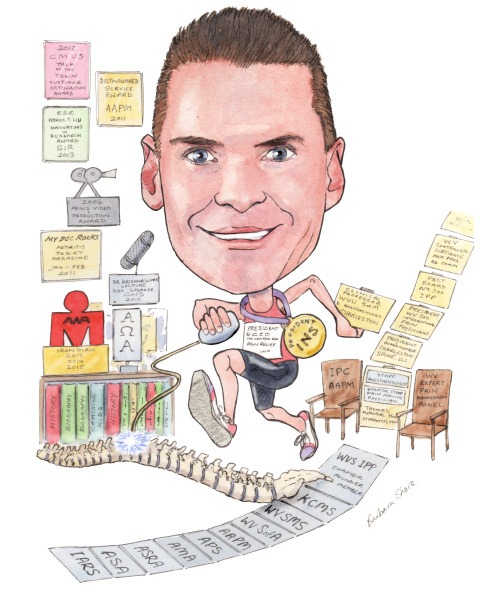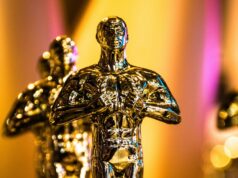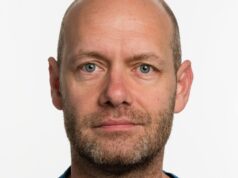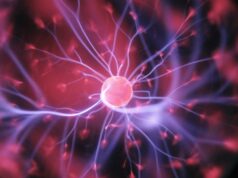
Timothy Deer (Centre for Pain Relief, Charleston, USA) has recently been appointed president of the International Neuromodulation Society. He believes neuromodulation is now the standard of care for pain with a neuropathic component and that it will become widely adopted as knowledge and experience of the intervention spreads. He talks to NeuroNews about his career highlights.
What drew you to medicine and to neuromodulation and pain management in particular?
I grew up in a small town where coal mining was the most common job. As a young child I realized that I had an attraction and calling to medicine and that I did not want to work in the mines. I decided in second grade that I wanted to go to medical school. That goal stuck and led me to West Virginia University School of Medicine. I became interested in Pain Medicine while at the University of Virginia. I never knew there was an interventional aspect of this field, and when I saw the impact that had on patients I decided to make this area of interest my life long body of work.
Who were your mentors and what wisdom did they impart to you?
Jim Cottrell is an anaesthesiologist and thought leader who is a past president of the American Society of Anesthesiology. More importantly to me, he is my uncle and father figure who has been a constant source of wisdom and insight.
John Rowlingson is a regional anaesthesia and pain medicine expert at the University of Virginia. He was the first anaesthesiologist I met who focused on pain. When other faculty discouraged me to follow this path John was a steady influence on focusing on pain treatment, functional improvement and quality of life while reducing the need for opioids.
Many of my colleagues have taught me new methods, thought processes and algorithms. Sam Hassenbusch, John Oakley, Elliot Krames, Rob Levy, Liong Liem, Chris Kim, Stanley Golovac, Rick Bowman, Peter Staats, Sudhir Diwan, Simon Thomson, and many others have given me insight that I have implemented into my practice. I am also inspired by many of the younger generation making an impact on our field at this time. New thought is critical to the long term health of the field of Neuromodulation.
My most important advice comes from two sources outside of medicine. My wife, Melissa, who has been my advisor for over 25 years and has been a constant steady force in a tumultuous world. I also have a daily interaction with God where I gain strength in both times of joy and strife.
What has been your most memorable case, and why?
I have so many that it is very hard to choose. In recent years I was moved when I placed my first Dorsal Root Ganglion Spinal Stimulation system in Europe. I had been involved in the development of that therapy for many years and to see it being used in the pain algorithm was a real thrilling moment for me. In that particular case the patient had failed more than ten surgeries, multiple drugs, and therapy. The surgical team was considering amputation of the lower limb. DRG stimulation led to a tremendous amount of relief and it seemed to occur almost immediately. This structure had been the key missing target for several months of suffering. I will never forget the emotion of the patient in the recovery room, and her family later that day.
What are the three most important innovations in neuroscience in the last 10 years?
- Dorsal Root Ganglion Stimulation
- High Frequency Stimulation
- Burst Stimulation.
From your research and experience, what motivates you?
I am motivated by the continuous desire to improve the life of my patients and those who suffer worldwide.
You have been principal investigator in many trials over the years, why do you consider research to be so important?
The patients deserve the best therapies that current technology allows. The continuous desire to improve outcomes, improve function and lower costs of care are all achieved through successful research.
What are your current areas of research focused on?
- New uses of Dorsal Root Ganglion Stimulation
- Feedback mechanisms of Spinal Cord Stimulation to improve outcomes
- Indication expansion of High Frequency Spinal Cord Stimulation
- Indication expansion for Burst Waveform Spinal Cord Stimulation
- New methods of Sacral Nerve Stimulation to improve the care of those with Urinary and Faecal Incontinence
- Spinal cord stimulation for heart failure.
Do you believe that neuromodulation should become the standard of care for the treatment of chronic pain?
I believe it is the current standard of care in those with a neuropathic component of pain. It has been slowed by a lack of knowledge of the public and primary care physicians about the possibilities of this therapy. As outcomes improve and the internet spreads information, this is improving greatly.
Wide spread adoption has also been slowed by over prescribing of opioids in many patients who were stuck in the treatment regimen despite a poor outcome. Now we are learning that this is not an optimal solution to chronic pain in most patients.
Recently, there has been a lot of debate surrounding the use of paraesthesia in spinal cord stimulation. Do you think paraesthesia-free stimulation is the future? And is there still room for paraesthesia in pain relief?
I think the future is the ability to offer more than one option for a patient using one device. That may include paraesthesia free, paraesthesia, new targets, and new waveforms. I am excited to play a role in this new change of algorithm.
What do you believe are the three main questions in the field of neuromodulation that remain unanswered?
- How do we improve patient selection for each of these therapies?
- How can we individualise therapy to make the most efficacious choice based on neural response?
- What other diseases can we effectively treat and change the disease process outside of the realm of pain management?
You have recently taken on the role of president of the International Neuromodulation Society, what are you plans for the development of the society?
We want to increase involvement of the international membership in decision making. We also hope to impact the amount of collaborative research done throughout the world by promoting technology base algorithm sharing. Other goals include improved patient access in developing countries, improved physician training on safety and efficacy, and continued product development to improve care by bringing interested parties together to change the normal thought processes.
What are your interests and hobbies outside of medicine?
I have enjoyed being involved in my four children’s sports endeavours over the years as a coach, team doctor, or proud dad. I am an avid reader of history and biographies.
I am an endurance athlete. It is my healthy addiction. I am a Leadville 100 mile run finisher, a 13 time Ironman competitor including the World Championships in Kona, and have ran over 60 marathons. I plan to continue these events as long as I am blessed with good health.
Fact File
Current appointments
President and chief executive officer of the Center for Pain Relief, Inc
President of the International Neuromodulation Society
Education
1994 Clinical Subspecialty Pain Fellowship, The Pain Management Center, University of Virginia
1991–1994 Anesthesiology, University of Virginia School of Medicine
1990–1991 Internal Medicine, University of Virginia School of Medicine
1986–1990 Medical Doctorate, West Virginia University School of Medicine (Graduate with Highest Honors, Alpha Omega Alpha)
Research
Principal investigator for over 20 trials, including:
MIDAS ECO
PAIN
MILD
Professional organisations (selected)
Member, Board of Directors, North American Neuromodulation Society (2004–2008)
West Virginia Society of Interventional Pain Physicians, Founding Member of Chapter (2003–present)
Member, North American Neuromodulation Society (1998–present)
Member, West Virginia Society of Anesthesiologists (1994–present)
Member, American Academy of Pain Medicine (1994–present)
Member, International Spine Intervention Society (2010–present)
Honours and awards (selected)
2013 SSR Patrick T Liu Innovations in Research Award, Society of Interventional Radiology Annual Meeting
2011 Distinguished Service Award, American Academy of Pain Medicine
2010 Dr Krishna Kumar Lecture Distinguished Speaker presented by the Canadian Neuromodulation Society Annual Meeting









